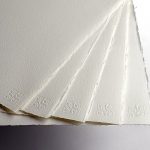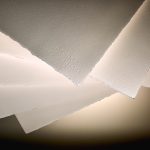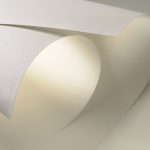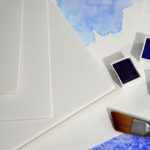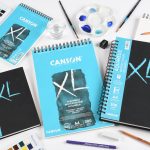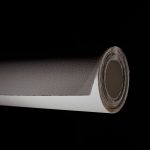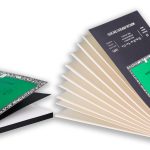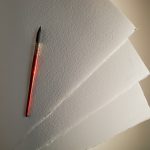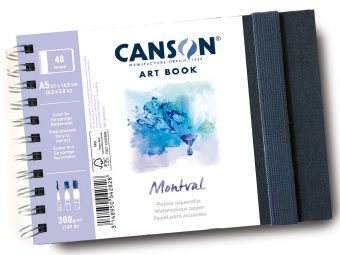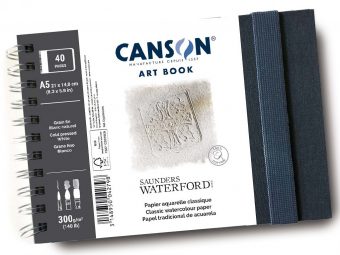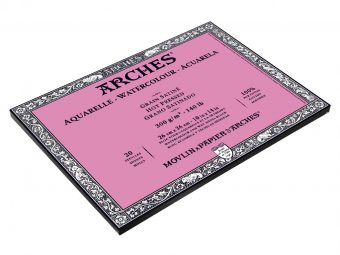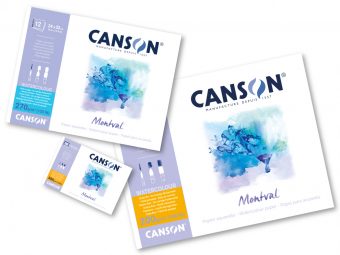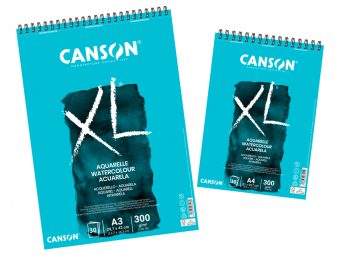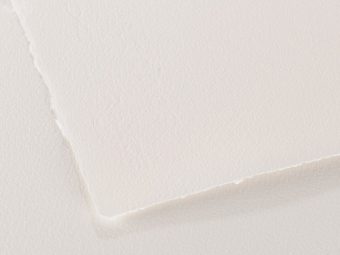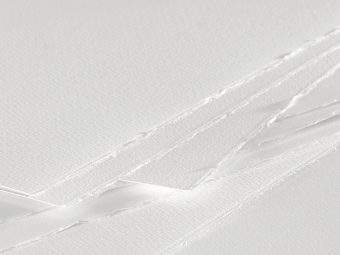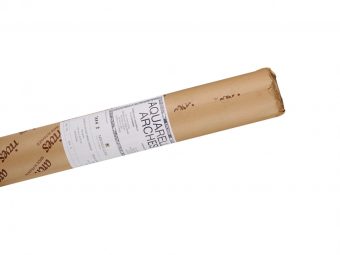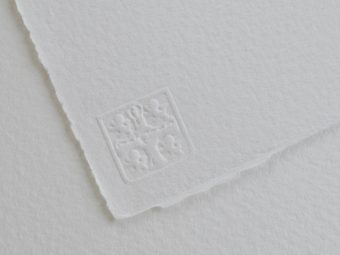Watercolour paper is much more than just paper – it’s a tool that directly affects the behaviour of paint, water resistance, layering, and the final impression. Choosing the right one may seem daunting at first, but finding the right paper becomes a creative and exciting process once you know what qualities to look for.
In this post, we’ll go over what watercolour paper is made of, the textures and formats available, and how to choose the right one to support your painting style.
Cotton or cellulose – what is watercolour paper made of?
The quality of watercolour paper begins with its composition. The mix from which the paper is made – whether cellulose or cotton – determines its strength, absorbency, durability, and price.
Cotton paper
Watercolour paper made from 100% cotton is the professional choice. Cotton fibres are long and strong, giving the paper exceptional durability. It doesn’t buckle easily, withstands lots of water and multiple layers, and allows for blending and lifting colours without damaging the paper.
Cotton paper can be made from various sources: for example, cotton linters (the most common material in watercolour paper), calico (recycled cotton fabrics), or other textile remnants. Some manufacturers label their paper as “100% rag” or “cotton rag” – which may indicate it’s made from calico rather than linters, but both are professional-quality options.
Cotton papers are more expensive but ideal for both large-scale works and detailed finishes where you don’t want to compromise on quality.
Cellulose paper
Watercolour paper made from wood pulp or cellulose is a more affordable alternative, great for learning, quick sketches, or experimenting with simpler techniques. While cellulose doesn’t behave the same as cotton when wet, good results can still be achieved with careful water control and avoiding overly wet techniques. For instance, it tends to warp more and may deteriorate under heavy treatment.
Many beginners start with cellulose paper, as it allows more practice for a lower investment. However, keep in mind that pigments don’t always absorb evenly and may result in unexpected blotches or colour edges.
Cotton–cellulose blend
Some paper manufacturers offer mixed papers with, for example, 25% or 50% cotton content. These provide a middle ground: better absorbency and durability than 100% cellulose, but more affordable than full cotton paper.
Paper sizing
Paper sizing is a crucial part of watercolour paper quality – it determines how well the paper can control water and pigment. Sizing limits excessive absorption into the fibres, increases the paper’s durability and stability, and affects how paint behaves on the surface.
Sizing agents are often gelatin, starch, or synthetic adhesives – the choice depends on price range, quality, and whether the paper is vegan-friendly. Gelatin is a traditional animal glue used in higher-grade cotton papers. Synthetic or plant-based alternatives are common in more affordable products.
Watercolour paper is typically sized in two stages:
- Internal sizing is added to the pulp itself. This prevents excessive absorption into the fibres, makes colours more vibrant and transparent, and helps avoid feathering on scratched or altered areas.
- Surface sizing is applied to the finished paper using a special press. This top layer adds stability, prevents fuzzing, and directly influences how long you can work with wet paint, how well pigment spreads, and how easily paint can be lifted or new layers added.
If you find that paint absorbs immediately and dries unevenly, the issue may lie in the sizing, not just the material.
Different watercolour paper textures
The texture of watercolour paper affects how the brush glides, how much pigment the paper absorbs, and the final visual effect.
- Hot Press – Smooth and dense surface where paint sits longer on top. This gives you more working time and suits detailed illustrations, portraits, and ink combinations. It’s also a good choice for scanning and printing.
- Cold Press / NOT – The most versatile option. A medium-grain surface suitable for both wet-on-wet and layered techniques. Pigment settles nicely into the texture, giving a rich result without overly interfering with detailed work. Most artists use this for everyday painting.
- Rough – The most heavily textured and natural-looking surface. It creates organic, expressive effects – paint disperses unevenly but dynamically. Great for looser styles where texture plays a major role in the final result.
- Torchon – Informally known as “orange peel” or “cellulite” texture, reminiscent of handmade paper. Paint spreads softly and broadly, creating dreamy, misty effects. Ideal for atmospheric works where light and tone set the mood more than details.
- Other variations – In addition to classic textures, some manufacturers offer special surfaces – for example, lightly textured sketchbook paper not specifically meant for watercolour but suitable for light layering or mixed media. Some watercolour papers are double-sided, with one side smoother and the other rougher.
What else should you consider about watercolour paper?
In addition to composition and texture, the following factors may also influence your painting experience:
- Paper weight – The weight of the paper affects how well it handles water and whether it tends to buckle. Most watercolour papers are 300 gsm, which is ideal for water-heavy techniques and doesn’t always need stretching. Lighter papers (e.g. 190–250 gsm) may require stretching to prevent warping, while very heavy papers (425 gsm and above) stay flat even without support and are suited to more intense work.
- Paper tone – Watercolour paper tone can vary from classic cream (natural white) to bright white (extra white), depending on the brand. A warmer tone gives a softer look and suits landscapes or portraits, while a bright white surface makes colours pop with higher contrast – ideal for illustration or detailed work. The tone doesn’t indicate paper quality but rather suitability to your style and desired outcome.
- Paper buckling – Even high-quality paper tends to buckle or warp slightly when wet, especially if a lot of water is used. Cotton paper buckles more evenly and dries flatter than cellulose, which may stay more crinkled. If you want a perfectly flat result, it’s recommended to dampen the paper beforehand and tape it to a board to dry – this prevents unevenness.
- Correct paper side – Machine-made watercolour paper usually has one slightly smoother side – this is the painting side. The reverse may feel rougher or uneven. Handmade paper can often be used on both sides, though one is usually slightly more refined. You can also identify the correct side by the watermark – if the text reads correctly, the paper is the right way up.
- Deckled edges – Many watercolour papers, especially sold as single sheets, have deckled edges on all four sides. These aren’t just decorative – deckled edges indicate handmade or mould-made paper, often of higher quality. They also add character and a gallery-ready feel to the finished work.
In what forms is watercolour paper sold?
Watercolour paper is available in various formats, each with its own advantages depending on the nature of your work, habits, and practical needs:
- Sheets – Single sheets are a flexible option for those who want to cut paper freely or use special formats. These often have deckled edges on all four sides and are available in various sizes. Single sheets are most commonly sold as high-quality cotton paper.
- Blocks – Gummed blocks are a convenient solution if you want to avoid paper buckling while painting. Sheets are glued on one or more sides and once dry, the work can be removed by slicing along the edge with a blunt knife. A great choice for plein air or travel painting.
- Spiral and glued pads – Convenient for sketching and practice. Sheets can be easily torn out, and their lightweight makes them ideal for portability. Many glued pads come with a removable cover sheet to protect the first page from damage.
- Rolls – If you’re working on a large-scale piece or want to determine the format yourself, a roll is an excellent choice. You can cut the paper to your desired size and then frame or stretch it as needed.
When choosing the form, consider how you usually work – do you paint in a studio, while traveling, or outdoors? Do you want a flat result without mounting, or do you enjoy the process of stretching and fixing the paper onto a board yourself?
How to Make the Right Choice?
Once you’re familiar with the paper’s composition, texture, tone, and format, choosing becomes much easier. Still, it’s worth considering the following nuances:
- Think about what you paint. If you love detailed work, a smoother hot-pressed paper may be the better choice. If you enjoy a looser, more expressive style, you’ll likely prefer a rougher cold-pressed or textured “rough” surface.
- Take your technique into account. Wet-on-wet techniques require a strong, moisture-tolerant surface such as 100% cotton paper. If you work in layers with dry brushes, a high-quality cellulose paper may also perform well.
- Start with small tests. Before committing to a large quantity, try out different brands and surfaces. Many manufacturers offer small-format sample sets or individual sheets that let you get a feel for what suits your style best.
Choosing watercolor paper is a very personal process and evolves over time. The best way to find what works for you is to experiment – trust your eye and your hand.
In Conclusion
At first glance, choosing watercolor paper can feel overwhelming, but once you understand its main characteristics – composition, texture, weight, tone, and format – the decision becomes much simpler. Every artist works differently, and it’s completely normal to discover your favorites gradually. Don’t be afraid to experiment with various surfaces, observe how the paper responds in your hands, and let yourself be inspired by the materials that support your creativity. The right paper won’t make you a better artist overnight, but it can help you express your ideas more confidently and freely.


